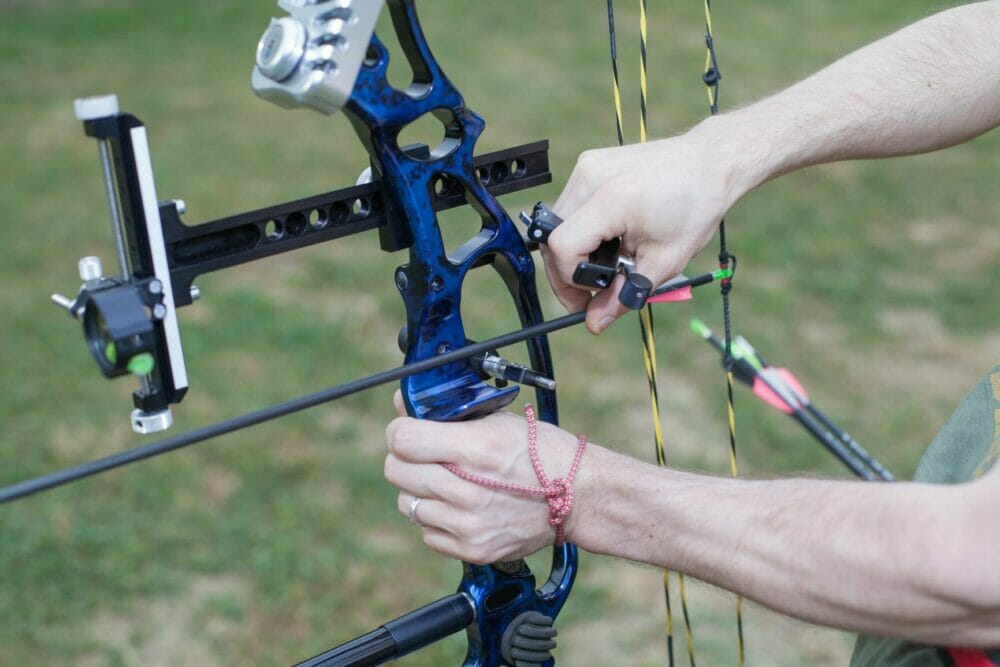A release aid is easy to use when shooting. It helps with aim, it can save the bowstring from damage, and it stops too much tension from being placed on the fingers.
If you’re a beginner, it’s good to start with a release aid to learn your stance. When you’ve always used one, it’s hard to imagine doing anything different.

It can seem strange to remember at one point no one would have had access to a release aid at all. Bows and arrows have come a long way quickly.
Now, there’s so much technology available to make archery easier and achievable. At some point, you forget what’s necessary, and what’s merely helpful.
A release isn’t necessary to shoot a compound bow. It has its advantages, but it is possible to shoot a compound bow without a release.
Can you shoot a compound bow without a release?
Yes. The main reason to use a release with a compound bow is that the shorter string of the compound bow is more likely to get caught on your fingers on release. This may happen unintentionally, but it can interfere with the release and flight of the arrow.
To shoot a compound bow without a release, first you’ll want to consider your equipment. A compound bow for finger use should be over 40 inches, so you’re less likely to catch the string on release.
Next, you need to learn how to use your fingers. A compound bow can be released with 2 or 3 fingers, but 2 is recommended. Grip the bowstring far down your finger. Holding it in the fingertips is a bad idea, as it’s harder to create tension and easier to lose your grip.
The tension is an important factor. Hold your back tight, and keep your fingers relaxed until at full draw. It’s best to experiment with finger positions, the amount of fingers used, and the pressure exerted. It’s important to find what’s comfortable for you.
Practice is vital, especially if you want to go hunting. Switching from a release aid to fingers will take some adjustment. You don’t want to be learning how to do it when you might scare the targets off. Practice before you go out, so you have the mechanism sorted. You want the release to be smooth and consistent.
At first, it may feel more difficult than you expected. If you’re switching from using a release aid, you may find it harder to sight a target, or hold a stance. This is probably because of the newness of the technique. With practice, you will regain old skill.
Can you shoot a compound bow without an arrow rest?
You can shoot a compound bow without an arrow rest, but it’s not recommended. An arrow rest improves accuracy, and often come standard with a compound bow. Without the arrow rest, you lose a great deal of the advantages of a compound bow.
Accuracy becomes more difficult, aim is harder, and precision is lost. If you want to shoot best, definitely use an arrow rest.
If you wanted to shoot without an arrow rest, it will take a lot of practice. First and foremost, putting the arrow in the correct position. Then, the test will be to maintain the position of the arrow throughout aiming. Finally, ensuring the arrow doesn’t fall or dip as you shoot, so it can fly with accuracy.
Where shooting a compound bow without a release is possible and fairly quick to learn, using one without an arrow rest is incredibly difficult. Doing so removes many of the advantages (and enjoyments) of using a bow.
How do you aim a bow without sights?
Shooting a bow without a sight is a good skill to have. However, learning it is difficult, especially for beginners. It’s known as instinctive archery, because it relies on many of the skills that in the past were all we had available.
The first step is your stance. Stance is important to all archery. Stand at a 90° angle to your target, with your feet a shoulder width apart and in line with your target. Your stance should feel comfortable.
Draw the bowstring to a semicircle, using your back muscles for power. Pull the string smoothly in one motion for a better shot.
Your eye should remain focused on the target, and your chin perpendicular to the ground. Keep yourself steady, to ensure the best release and aim of the arrow. Concentrate on the exact spot you want to hit, and keep watching.
To aim without a sight is a combination of luck and practice. At first, it will be luck, and then it will become practice. Keep your stance relaxed and comfortable, keep your eye on the target, and release.
